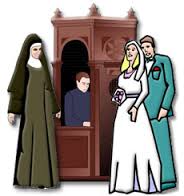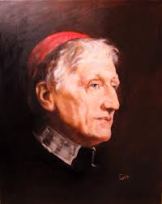 I recently read with much interest the first installment of Archbishop Naumann’s “call story” (Leaven, 11/1/13), which ends with our shepherd as a college student in the late 1960s, discerning the path he should take in life. Though we pretty much know how the story ends, it will be fascinating to read next week about how Our Lord led him from point A to point B.
I recently read with much interest the first installment of Archbishop Naumann’s “call story” (Leaven, 11/1/13), which ends with our shepherd as a college student in the late 1960s, discerning the path he should take in life. Though we pretty much know how the story ends, it will be fascinating to read next week about how Our Lord led him from point A to point B.
The article made me recall my own experience of the 1960s, especially 1968, which sticks in my memory as a most significant year. I remember the year beginning with the Packers’ second straight Super Bowl victory and ending with Richard Nixon’s narrow victory over Hubert Humphrey and George Wallace (I was allowed to stay up late and watch the election coverage). I remember Bobby Kennedy being shot only a couple miles from my house and the rioting that accompanied the Democratic convention.
Mostly, though, I was a chubby third-grader at St. Elizabeth’s parish school, oblivious to most of what was going on in the world and in the Church. Whether I was playing kickball in the schoolyard or humming “Kumbaya” as I crafted nifty collages from magazine scraps, I was largely shielded from the cultural changes going on in our society, from the civil rights movement and Vietnam to Woodstock and women’s “liberation.”
These were mostly dark days for the Church. Today there’s the enthusiasm of the “new evangelization” and the great influx of converts. Back then, however, there were people jumping ship in unprecedented numbers. And not just priests and religious. All of us experienced the exodus of relatives and friends from the Church.
Yet, amidst the turmoil, three significant events occurred in 1968 that I think planted seeds of hope for future generations.
Rocking the Credo
The first event was the issuance of the Credo of the People of God by Pope Paul VI. The publication of new, official expressions of the Catholic faith is a rare occurrence. Further, Pope Paul’s Credo is much more detailed than the more familiar Apostles’ Creed or Nicene Creed.
Popes don’t issue documents such as this lightly or without a significant reason. In this case, Pope Paul VI saw the emerging crisis of faith in the West and tried to minimize its effects. In explaining why he was issuing his Credo, the Holy Father remarked that “many truths are being denied outright or made objects of controversy,” leading to “disturbance and doubt in many faithful souls.”
The Credo was issued at the conclusion of a “Year of Faith.” Hmmm.
I’ve heard references to the “missing generation” created by the millions of abortions in this country in recent decades. But the prior generation–those of us who were raised in the 1960s and 70s–is spiritually missing. A significant aspect of the new evangelization is to welcome this generation back into the Church. Pope Paul’s Credo, amplified 25 years later in the Catechism of the Catholic Church, reflects the Church’s renewed commitment in our day to proclaiming the person and teachings of Jesus Christ to our world.
Separate Lives
There’s the well-known Latin expression, “lex orandi, lex credendi,” which means that how we pray affects what we believe. I think we can further say, “lex credendi, lex vivendi,” because what we believe (or not believe) affects how we live.
And so, in addition to the millions of Catholics who have formally abandoned the faith over the past 40 years, there are countless others who in some fuzzy manner consider themselves Catholic, but who, as recent Popes have noted, are leading lives that are far removed from the Gospel.
We were rightly horrified by the revelation of sexual misconduct on the part of a handful of priests this past decade. But to be honest, the rest of us haven’t fared much better. In recent decades, Catholics have been fornicating, cohabitating, divorcing, contracepting, sterilizing, and aborting at a scandalously staggering rate. And the underlying loss of a sense of sin and grace–what we typically call “secularization”–has affected all aspects of human activity, from dwindling Sunday Mass attendance and Confession lines to a general decline in civility and solidarity among people. I’ve read dissident theologians who justify virtually any kind of behavior out of a mistaken understanding of conscience, and of course today pro-homosexual activists have experienced unprecedented success in their efforts to gain societal approval of unspeakably sinful behavior.
In the face of this enormous societal pressure, the Church–if she weren’t specially protected by the Holy Spirit–could easily cave in. Instead, she has steadfastly and compassionately proclaimed the timeless truths of our Christian faith and our human nature in response to the visceral demands of contemporary society.
Perhaps the most significant case in point of the Church’s fidelity is the issuance of Humanae Vitae by Pope Paul VI in 1968, in which the Holy Father reiterated the Church’s constant teaching on the immorality of artificial birth control.
The rebellion against Humanae Vitae affected every segment of the Catholic population in the United States. I remember as a teen and young adult how the Church’s teaching in this area was ridiculed and dismissed. The Church seemed so out-of-touch with our “sex, drugs, and rock n’ roll” culture.
But, to steal a line from a 1960s pop icon, “the times they are a changin’.” Young people are now taking to heart the Church’s teachings on human sexuality and the “theology of the body”–as is an older, broken generation that’s increasingly aware of having been betrayed by the so-called “sexual revolution.” More bishops and priests are breaking the “great silence” through sound preaching and teaching on contraception, aided by various organizations that promote marital chastity and natural family planning.
The Church is the “pillar and bulwark of the truth” (1 Tim. 3:15). Amidst the confusion of the ’60s, Pope Paul VI courageously reminded us of God’s magnificent plan for human sexuality, a reminder that needs to be repeated–and lived.
The third seed of hope that I believe was planted in 1968 was the establishment by H. Lyman Stebbins of a lay organization called Catholics United for the Faith (“CUF”). Here were Catholic men and women acting upon the godly instinct–the fruit of a deep spiritual life–to come to the Church’s aid in her time of grave need. And, I might add, in doing so they were explicitly trying to manifest Vatican II’s rich teaching on the role of lay Catholics in the Church. For their trouble, they were often ostracized, vilified, and even treated as enemies of the Church. I was part of the second generation of CUF leadership in the 1990s and early 2000s. One board member reminded me that even then, in many dioceses, CUF had to “sit on the back of the bus.”
With the perspective of 40+ years, CUF’s positions have largely been vindicated. As Catholic Answers’ Karl Keating once wrote, on all the make-or-break issues in the Church, “CUF has been on the side of the angels (not to mention the side of the popes). It’s an enviable record of fidelity.” From the side of CUF have come wonderful apostolates, resources, and ministries, most notably FOCUS, the critically acclaimed Faith and Life catechism series, and Emmaus Road Publishing. By their fruit you will know them.
We Hold On
My family loves C.S. Lewis’ Narnia Chronicles. In the second story in this series, Prince Caspian, things are looking especially bleak for old Narnia, which is under attack. Many old Narnians have lost their faith in Aslan (the Christ figure in the story) and refuse to back the legitimate child-king, Caspian. Yet, there is one notable supporter of King Caspian among the talking beasts, Trufflehunter the badger, who says, on behalf of the badgers, that “we hold on.” While others have forgotten about Aslan and the need for a human of Caspian’s line to rule Narnia, the badgers couldn’t be moved. Trufflehunter says to Caspian, “as long as you will be true to old Narnia you shall be my king, whatever they say. Long life to your majesty.”
I was urged by some during my tenure with CUF to distance myself from CUF’s past, to make a fresh start. Appealing as that sounded at times, in the end it would have been a treacherous act of disloyalty. It would have done a grave injustice to the heroic CUF members who did their best to “hold on,” to follow Christ’s vicar on earth and pass the torch to the next generation.
“CUF” does not stand for Catholics United “against the Faithless” or “against the Fornicators.” Rather, it stands for Catholics united “for the Faith.” And isn’t that what all Catholics in Northeast Kansas desire–to help all men and women achieve true, lasting unity by discovering or rediscovering the pearl of great price?
Emboldened with a new ardor, and armed with new methods and expressions, let us embrace the new evangelization as the great work of the Holy Spirit in our time!
Tags: contraception, culture war, faith, laity, new evangelization, scandal, Year of Faith










